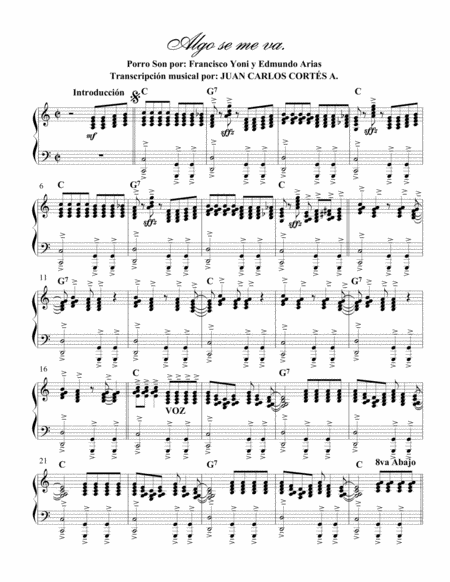Piano Solo - Digital Download SKU: A0.958735 Composed by Francisco Yoni y Edmundo Arias. Arranged by Juan Carlos Cortés A. Christmas,Concert,Latin,Standards,World. Score. 3 pages. Juan Carlos Cortés Aguirre #6117911. Published by Juan Carlos Cortés Aguirre (A0.958735). Transcripción para Piano Solo por:JUAN CARLOS CORTÃS A.Basado en la grabación fonográfica original de: EDMUNDO ARIAS Y SU ORQUESTA, acompañando a la Argentina Lita Nelson en el porro: ALGO SE ME VA. Lita Nelson (MANUELITA FERNANDEZ NELSON), cantante argentina y quien se radicó en Colombia en el año de 1958, dando inicio a su carrera musical.- Edmundo Dante Arias Valencia (Tuluá, Valle del Cauca, 5 de diciembre de 1925 - MedellÃn, 28 de enero de 1993), hijo del compositor antioqueño JoaquÃn Arias, fue un multi-instrumentista y compositor de música colombiana --destacado en el género de la cumbia--, creador de piezas musicales, difundidas principalmente a través de su grupo musical, la Orquesta de Edmundo Arias. De 67 años de edad, falleció en el Hospital Universitario San Vicente de Paúl de la ciudad de MedellÃn, a causa de una uremia sobreviniente a un procedimiento de vesÃcula biliar.Francisco Yoni (Francisco Fortunato Silva) el autor de SON COSAS MÃAS, vino a MedellÃn en la década del 50, a fines de ella, y se acreditó como periodista. Mantuvo un gran programa tanguero en la Voz de Antioquia y dentro de él una sección que bautizó El Tango Poemizado. Se trataba de versos suyos sobre un conocido tango. Esa sección gustó mucho y circula un LP con doce temas de Yoni en esa tónica.Algo Se Me VaPorro Son por: Francisco Yoni y Edmundo AriasINTRODUCCIÃN:Cuando tú me besas algo se me va,Se me va la fuerza de la voluntad,Cuando tú me besas algo se me va,Se me va la fuerza de la voluntad.Me tiemblan las piernas, quedo sin razón,Es inexplicable toda esta emoción,Me da un cosquilleo y lo siento aquÃ,Me da un cosquilleo y lo siento acá.Ay papi, no beses asÃ,Tengo, suficiente ya,Basta, basta de una vez,Ay mira, me voy a caer.Mami, yo soy muy feliz,Mira, besándote asÃ,Mami, yo soy muy feliz,Mira, besándote asÃ.Papi, no beses asÃ,Tengo, suficiente ya,Basta, basta de una vez,Ay mira, me voy a caer.INTERLUDIO:Cuando tú me besas algo se me va,Se me va la fuerza de la voluntad,Cuando tú me besas algo se me va,Se me va la fuerza de la voluntad.Me tiemblan las piernas, quedo sin razón,Es inexplicable toda esta emoción,Me da un cosquilleo y lo siento aquÃ,Me da un cosquilleo y lo siento acá.Ay papi, no beses asÃ,Tengo, suficiente ya,Basta, basta de una vez,Ay mira, me voy a caer.Mami, yo soy muy feliz,Mira, besándote asÃ,Mami, yo soy muy feliz,Mira, besándote asÃ.Papi, no beses asÃ,Tengo, suficiente ya,Basta, basta de una vez,Ay mira, me voy a caer.CODA.
